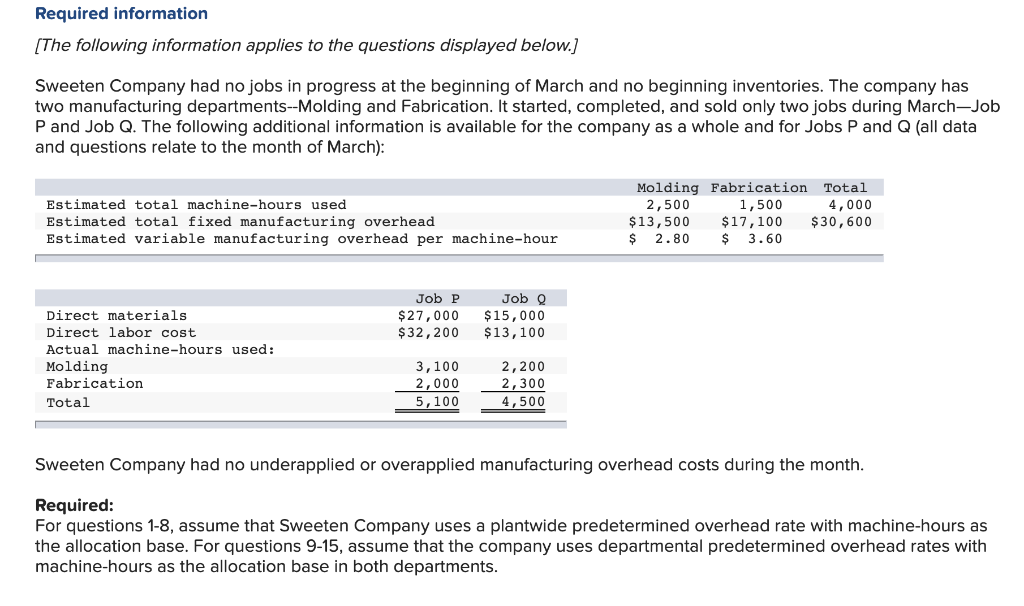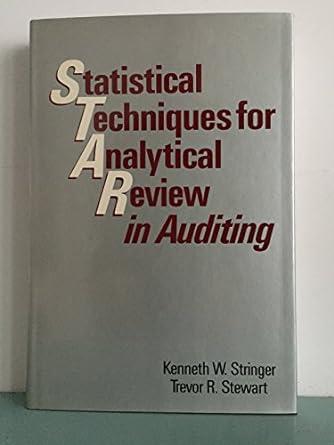















Required information [The following information applies to the questions displayed below.] Sweeten Company had no jobs in progress at the beginning of March and no beginning inventories. The company has two manufacturing departments--Molding and Fabrication. It started, completed, and sold only two jobs during March-Job P and Job Q. The following additional information is available for the company as a whole and for Jobs P and Q (all data and questions relate to the month of March): Estimated total machine-hours used Estimated total fixed manufacturing overhead Estimated variable manufacturing overhead per machine-hour Molding Fabrication Total 2,500 1,500 4,000 $13,500 $17,100 $30, 600 $ 2.80 $ 3.60 Job P $27,000 $32,200 Job Q $15,000 $13,100 Direct materials Direct labor cost Actual machine-hours used: Molding Fabrication Total 3,100 2,000 5,100 2,200 2,300 4,500 Sweeten Company had no underapplied or overapplied manufacturing overhead costs during the month. Required: For questions 1-8, assume that Sweeten Company uses a plantwide predetermined overhead rate with machine-hours as the allocation base. For questions 9-15, assume that the company uses departmental predetermined overhead rates with machine-hours as the allocation base in both departments. 1. What was the company's plantwide predetermined overhead rate? (Round your answer to 2 decimal places.) Predetermined overhead rate | 2. How much manufacturing overhead was applied to Job P and how much was applied to Job Q? (Do not round intermediate calculations.) Job P Job Q Manufacturing overhead applied 3. What was the total manufacturing cost assigned to Job P? (Do not round intermediate calculations.) Total manufacturing cost 4. If Job P included 20 units, what was its unit product cost? (Do not round intermediate calculations. Round your final answer to nearest whole dollar.) Unit product cost 5. What was the total manufacturing cost assigned to Job Q? (Do not round intermediate calculations.) Total manufacturing cost 6. If Job Q included 30 units, what was its unit product cost? (Do not round intermediate calculations. Round your final answer to nearest whole dollar.) Unit product cost 7. Assume that Sweeten Company used cost-plus pricing (and a markup percentage of 80% of total manufacturing cost) to establish selling prices for all of its jobs. What selling price would the company have established for Jobs P and Q? What are the selling prices for both jobs when stated on a per unit basis assuming 20 units were produced for Job P and 30 units were produced for Job Q? (Do not round intermediate calculations. Round your final answers to nearest whole dollar.) Job P Job Q Total price for the job Selling price per unit 8. What was Sweeten Company's cost of goods sold for March? (Do not round intermediate calculations.) Cost of goods sold 9. What were the company's predetermined overhead rates in the Molding Department and the Fabrication Department? (Round your answers to 2 decimal places.) Predetermined Overhead Rate per MH Molding Department Fabrication Department per MH 10. How much manufacturing overhead was applied from the Molding Department to Job P and how much was applied to Job Q? (Do not round intermediate calculations.) Job P Job Q - Manufacturing overhead applied | 11. How much manufacturing overhead was applied from the Fabrication Department to Job P and how much was applied to Job Q? (Do not round intermediate calculations.) Job P Job Q Manufacturing overhead applied 12. If Job P included 20 units, what was its unit product cost? (Do not round intermediate calculations.) Unit product cost 13. If Job Q included 30 units, what was its unit product cost? (Do not round intermediate calculations. Round your final answer to nearest whole dollar.) Unit product cost 14. Assume that Sweeten Company used cost-plus pricing (and a markup percentage of 80% of total manufacturing cost) to establish selling prices for all of its jobs. What selling price would the company have established for Jobs P and Q? What are the selling prices for both jobs when stated on a per unit basis assuming 20 units were produced for Job P and 30 units were produced for Job Q? (Do not round intermediate calculations. Round your final answer to nearest whole dollar.) | Jobp Job Q Total price for the job Selling price per unit 15. What was Sweeten Company's cost of goods sold for March? (Do not round intermediate calculations.) Cost of goods sold






















